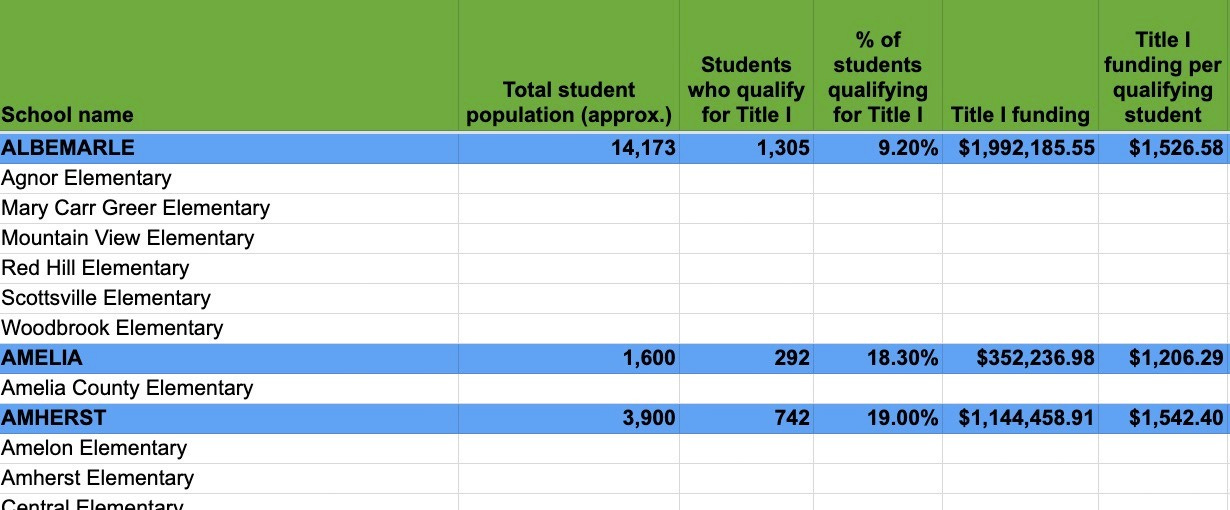The 109 local schools that will lose funding if the DOE closes
Is your child’s school on the list? Eleven in John McGuire's hometown are.

The Trump administration is preparing to shut down the Department of Education, evidently with the support of our congressman, John McGuire—or at least without objection from him. What would that mean for schools in the 5th congressional district?
Unfortunately, we don’t know enough yet to have definitive answers. The administration hasn’t provided any details about what a post-DOE system would look like. Secretary McMahon would be able to accomplish some of the closure on her own, but for other steps, she’d need Congress to pass legislation. There’s a good chance that Democrats could stop the biggest legislative changes, since they have enough seats in the Senate to stall most action there.
Bu keep in mind that Trump’s pending order is just the latest in a long-running effort by Republicans to shut down the DOE. So despite all that we don’t know, it’s worth making some educated guesses about what the administration will try to do. And we don’t have to guess how many of our schools would be affected—we know exactly how many, and which ones they are. Read on for more.
Where the department’s biggest programs would go
Let’s start by looking at what the administration will probably try to do. Since they’ve said so little, the best source is Project 2025, which proposes:
phasing out, over ten years, federal funding for schools with lots of students from low-income households (this is what’s known as Title I funding)
moving the college loan program to the Treasury Department
moving the civil rights office to the Justice Department
moving funding and oversight of Individualized Education Programs to Health and Human Services
109 schools in our district would lose funding—including 11 in Lynchburg
Of those four changes, eliminating Title I might have the biggest impact, because Project 2025 implies that states could make up the difference. Maybe they will, but counting on state governments to come up with millions more for education doesn’t strike me as sound policy.
I’ve put together a list of the 109 schools in John McGuire’s district that currently get Title I funding. I’ve grouped them by division, so you can see how much federal money goes to yours, as well as which schools get it.
As you can see, across VA-5, more than 17 percent of kids qualify for Title I funding—that’s almost 20,000 children. Not surprisingly, there’s a lot of variation within those numbers. Only 7 percent of the children in Powhatan County qualify, while 40 percent in Danville City schools do.
In Lynchburg City Schools, where Rep. McGuire’s office is located, the number is 30 percent. It’s a safe bet that he knocked on some of their parents’ doors as a candidate.
Here are all the affected schools in his home town:
Bedford Hills Elementary
Dearington Elementary
Heritage Elementary
Linkhorne Elementary
Paul Munro Elementary
Perrymont Elementary
Robert S. Payne Elementary
Sandusky Elementary
Sheffield Elementary
T.C. Miller Elementary
William M. Bass Elementary
What would these cuts mean in practice?
Here’s some rough math. If the average teacher makes $65,000, then losing $4 million—as Lynchburg stands to—translates to 60 teaching positions.
[Update: After I sent this post out, I realized this is an overestimate, because I didn’t account for the other costs that a district incurs when it hires someone. Once you add in benefits, payroll taxes, etc., a teacher making $65,000 might cost the district $100,000. So losing $4 million might amount to more like 40 teaching positions.]
Of course, they wouldn’t necessarily cut that many teaching jobs; they’d almost certainly spread the cuts across various programs. Meaning, in addition to possible job cuts:
larger classes
fewer math and reading programs
fewer or no after-school and summer programs
less help for kids who are still learning English
What about other programs?
Although Project 2025 envisions Title I funding being picked up by the states, it doesn’t get into the question of how or whether other DOE programs—like college loans and money for special education—would continue.
For example, if your child has a learning disability—autism, dyslexia, ADHD, a speech impairment, etc.—they probably qualify for extra help at school. That help is paid for by a mix of federal, state, and local funds.
Will that federal money keep flowing if oversight of special education is moved to Health and Human Services? Will the services that kids get be disrupted during the handoff? Who will hold schools accountable for civil rights violations?
Those would be good questions for our congressman.
What you can tell John McGuire
If you’re moved to call his office about these issues, here’s a sample script. (Personally, I find that having a note in front of me takes out some of the anxiety of these calls.)
Rep. McGuire’s DC office: (202) 225-4711
Hi, I’m a constituent and voter in the 5th district. My zip code is _____. [This helps the staffer on the phone confirm that you’re a constituent. Congressional offices only care about calls from people they represent.]
I understand that President Trump is going to order the Department of Education to be shut down.
I’m calling to ask the congressman to oppose closing the DOE. And no matter what, I’m asking him to protect Title I funding and the other crucial programs run by the DOE.
This issue matters a lot to me, and I’m going to be watching the congressman’s actions closely. Thank you.



